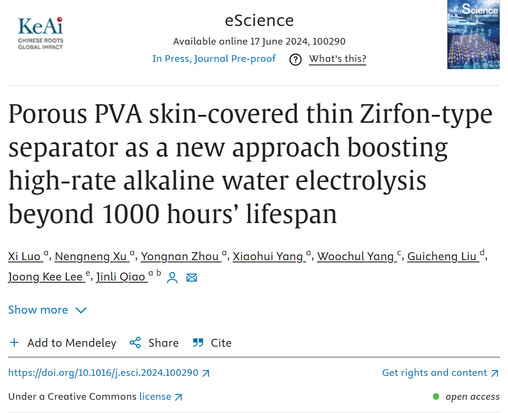A recent achievement was made by Professor Qiao Jinli’s team from College of Environmental Science and Engineering, Donghua University in the field of alkaline water electrolysis for hydrogen production. Their research, titled Porous PVA skin-covered thin Zirfon-type separator as a new approach boosting high-rate alkaline water electrolysis beyond 1000 hours’ lifespan, was published in the renowned international electrochemistry journal eScience. Using a dual-control strategy featuring surface engineering, the researchers successfully developed a thin zirconium-based composite membrane (V-Zirfon-350) with a hydrophilic porous skin layer. This involved fine-tuning the content and molecular weight of implanted pore-forming agents to create a unique mm-scale 3D interlocking nano-microstructure on the membrane surface. These innovations facilitated rapid ion channeling to enhance electrolyte transport while effectively improving the membrane’s conductivity to hydrogen ions and gas barrier properties. The first author of this paper is doctoral candidate Luo Xi from the College of Environmental Science and Engineering.


(Flow of Preparing V-Zirfon-350 Composite Membrane)
It successfully prepared a thin Zirfon-based composite membrane (V-Zirfon-350) with a hierarchical hydrophilic porous skin layer at a thickness of micrometers through surface engineering. It exhibits high KOH absorption (>90%), low surface resistance (~0.2 cm²), and ultra-low electrolyte permeation flux density (0.52 L·cm⁻²·s⁻¹@0.5 bar), significantly outperforming commercial Zirfon UTP500+ membranes. Coupled with efficient electrodes and advanced electrolysis cells, the V-Zirfon-350 membrane demonstrates a high current density of 1300 mA/cm²@2.0V. Furthermore, it operated continuously under rigorous conditions mimicking high and low temperature cycles in a series-connected dual-chamber electrolysis cell for over 1300 hours, with a cell voltage of only 3.5V. This paper provides a new strategy for the engineering, preparation techniques, and application of hydrophilic porous skin layers in zirconium-based composite membranes.

(V-Zirfon-350 Composite Membrane: Pore Size Distribution, Electrolyte Permeation Mechanism Schematic, and Surface/Cross-sectional Morphology)

(Excellent Hydrogen Production Performance of V-Zirfon-350 Composite Membrane under Simulated Harsh Conditions)


